
By Bob Goemans

Reprinted from Wetwebmedia.com with permission (BobFenner@WetWebMedia.com)
How's that song go? "I'm in the mood for a moray? Well guess what? Me too! Unfortunately, with the exceptions that we'll mention, as a rule moray eels are best left in the seas from which they came. Generally they get too big, are too ornery, even dangerous for aquarists, rendering bacteria-infested bites to the unwary. Of the several varieties often offered to the hobbyist, scads refuse food or readily escape the confines of too-small, inadequately-secured aquaria.
As is the intent of this series I will try to describe this group's spectrum of appealing and undesirable characteristics, encourage the keeping of it's more adaptable species, and offer fair warning of the shortcomings of the rest. Lastly we'll review details on selection and care.
This information is gleaned from scientific and pet fish literature sources and many years first hand experience in the wholesale livestock industry in ornamental aquatics.
The Group:
Morays are true eels (Order Anquilliformes) one of twenty some families, six-hundred plus species; as opposed to all the other so-called "eel-like" groups of fishes (e.g. wolf-eels that are actually blennies, family Anarrhichadidae spiny eels, Mastacembelidae; and many other non-true-eel groups that have many head lengths into body lengths appearance). Morays lack scales, caudal, pelvic and pectoral fins, instead locomoting with long, continuous dorsal and anal fins. Their scary-looking open-mouthedness is related to their possession of small, restricted gill openings without covers; they're breathing! Muraenids sport lateral line pores on their protruding heads, but not on the body. Think about this last characteristic. Makes sense for animals that spend most their time with just their head sticking out of cover.
There are twelve genera with about one hundred twenty described species of morays, about a dozen of which are regularly accessible to the hobby, with half of those being suitable. They're found worldwide in tropical to sub-tropical seas in shallow to moderate depths. According to Gonzales, in Hawaii they are the next most numerous reef animals after the wrasses, family Labridae.
Traits: The Good, The Bad & Definitely The Ugly:
The pro argument for moray eels is easy; there is such a sharp dividing line between "good" species and individuals and not-so-qualified. A suitable moray is extremely interesting behaviorally, adaptable to aquarium conditions, very disease-resistant and readily accepts offered foodstuffs. Lamentably these criteria exclude more than ninety percent of the family.
Size: The smaller morays attain two to three feet in overall length, the largest more than three meters; yes, close to ten feet. The photo of the Gymnothorax javanicus is a seven footer with a girth greater than your thigh and probably topping the scales at more than sixty pounds.
While it is true that they grow slowly, some having been kept in captivity for several decades, these animals require large living quarters. They are not easily "stunted" to the size of their aquarium. Most morays get to be big animals, requiring large tanks and efficient filtration systems. Crowding into a small system will result in escape behavior, otherwise poor adjustment, and fluctuating water quality.
Wound Danger:
As predators morays are opportunistic omnivores, trying to eat most any fish and/or invertebrate slow enough to grab. Their great sense of olfaction is coupled with bad vision. Whereas individuals in the wild and captivity can be quite docile, even playful, some species and individuals are highly dangerous if provoked or excited by food-smell, because of their bite.
Not all types of morays are nocturnal, shy and retiring; the pictured Panamic Green Moray, Gymnothorax castenatus is a less-than celebrated diver-chaser. They are unpredictable, and at times autistic, not distinguishing where food stops and your fingers start.
A few notes here regarding moray bites. Unless they feel threatened most will leave you alone. If grasped out of fear, looking for food or accident, a moray will let you go. No, you won't have to cut off it's head, geesh. The worst reaction is the most common and dangerous; to jerk your hand back in autonomic reaction, cutting yourself further on the recurved teeth and landscape.
The real problem with these bites is secondary infection. Microbes in the water whether associated with the moray's mouth or not may infect you through any break in your skin, from a bite scratch or puncture. Treat all these seriously. 1) Clean 2) Disinfect 3) Cover & 4) Periodically inspect all such wounds. If inflammation, pain persists I'd suggest a medical visit.
Using long plastic gloves dedicated for aquarium use will prevent most scrapes at home and keep hand-borne pollution down.
Should you be so inclined, or you find yourself on a television game show with a similar query, some morays have been involved in ciguatera (fish food) poisoning. If, when, where in doubt, don't eat them. I have, and they are nothing to write home about. Morays apparently become toxic up the food chain via bio-accumulation, ingesting benthic algae-eating herbivores.
If You're Still In the Mood For A Moray:
System Size, Configuration, Lighting...
Big, Bigger, Biggest; as large a system as possible. A minimum of forty gallons for the smallest of morays. Tank shape should obviously feature length and width versus "show" tank shape.
Hiding places? At minimum two pleasing ones large and dark enough to get entirely out of view.
Subdued lighting and darkened sides and backing are a bonus. Morays enjoy a high degree of routine in their environment and will appreciate a regular, timed light regimen.
Security:
Vying with starvation for the number cause of moray death is getting out of the tank and drying up. Look at your system from an aquatic Houdini's point of view. Are there any openings large enough to squeeze the animal's head through? It will. From the inside could you push any part of the top off with your hand and arm? It will. Even with the water level lowered morays can and will liberate themselves.
Tank-Mates:
Are all potential meals. even seemingly tough fare like puffers and triggers and otherwise smart, fast-moving basses, etc. may be sucked in, especially at night. Keep to a systematic feeding schedule or listen for thankful burps. They will even eat cleaner wrasses, but seem to leave symbiotic shrimps (Lysmata, Hippolysmata, Periclimenes) alone.
Different species of morays are rarely found together in the wild and do not generally mix well in captivity. Territoriality within species is not heard of either. Provide mucho space, nooks and crannies and carefully observe your charges.
Feeding, Routine:
All morays are carnivorous, some preferring fishes or invertebrates of different types. Are you looking at a piscivore (e.g. Gymnothorax) or invertebrate-eater (e.g. Echidna)? Check their teeth. Crushing molars are for crabs, etc., sharp pointy types for fish eaters.
New arrivals will most likely have to trained on live foods. The few species endorsed here almost always quickly adjust to a "feeding stick" routine. I advise building and using one made from rigid plastic doweling or tubing. Keep your hands out of the system for pollution and damage's sake.
Regularity is very important to these eels; smaller specimens may be fed twice a week, larger one's do very well with once a week. Try to schedule frequent water changes the day after these feedings. Provide food of appropriate size, morays don't chew. Cut up clams, shrimp, squid et al. will be much less messy swallowed in strips.
Treatment:
Is unnecessary if you select a healthy, clean specimen and provide a suitable habitat. The usual two to three week quarantine for newcomers is recommended. Stay away from copper compounds and the organophosphate DTHP (masoten, dylox, dipterex, neguvon...) containing remedies; these are deadly to true eels. If your specimen(s) seem to be developing a bacterial and/or fungal infection, check water quality, do a massive water change, or remove them to a treatment tank and treat with the antibiotic erythromycin (Maracyn) to reduce overall bacterial levels.
Don't fret too much if your eel goes on a hunger strike. Morays collected in the wild have empty stomachs and can go for long (months) without eating.
Water Quality:
Temperature tolerance is wide, 72-82 degrees F. for tropical species. Specific gravity is better a little high 1.022 to 1.025. For a useful indicator, keep your eye on pH; 8.0 or higher is a good value. For large, heavy fishes with lots of waste, morays can play havoc with metabolite build-up and related degrading water quality. Morays have a highly developed sense of smell; if there is too much organic or metallic matter, they will show it by behavioral and color changes.
Due to large mounts of proteinaceous food being converted a protein skimmer and power filter is a must. Good circulation, filtration and aeration are paramount. That threatening mouth opening portends not vicious demeanor, but a need for a lot of oxygen.
Frequent ten to twenty percent water changes are recommended. Weekly is ideal, maybe the day or two after feeding.
Keep heaters out of harm's way; where the moray will not smack it or get burned.
Reproduction:
Spawning has been observed in the wild with pairs swimming a sort of dance, releasing gametes into prevailing currents. Like all true eels morays have a bizarre larval stage (leptocephalus) with ribbon-like, transparent young.
Selection:
A) Make sure the prospective specimen is eating.
B) Check it's entire body for sores, scrapes, torn infected
fins. If present, leave it.
C) Are the fishes being cared for properly? If not, why? Offer your advice, place a deposit if you've just got to have it, and wait a couple of weeks.
Acclimation:
The main thing I want to stress here is to anticipate erratic activity when first introducing a new moray. Often they will swim about, head out of water, maybe searching for a way out. If to their liking your eel will settle on provided cover, keeping fellow fishes at bay. I'd leave lights on low on the tank or in the room for a few days. If you find your eel on the floor do try to re-constitute it by rinsing off and placing it in a quarantine tank and treating as above.
Moving:
Should be carefully planned and executed. Though morays are tough, they have soft and slimy skin that is easily abraded by rough handling. Netting them almost invariably results in a thrashing specimen on the floor, much frazzled hobbyist nerves and non-sanctioned use of bath towels. Do this instead: Procure a thick (or doubled semi-thick) fish bag(s), roll the edge up, place in a scooped-up fashion in the tank and scoot the moray into the bag underwater. Maybe needless to say, but carefully lift the eel with minimum water from the tank in the bag. Now wasn't that easier? Now let's chat concerning species to look for and one's to avoid.
Good to Great Captive Species of Morays:

Gymnomuraena zebra, the aptly named Zebra Moray is a slow-moving chocolate black with vertical white striped beauty. The suitability for aquaria of the species is reflected in longevity records. Our old service company had some in rentals for fifteen years. There are twenty-something year citations.
Echidna catenata, the Atlantic "Chain-Link" Moray at about two foot maximum is likewise easy to maintain and peaceful. Feed once a week with cut-up crab, shrimp, krill, squid...
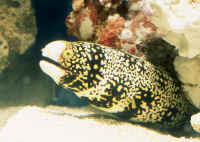
The Snowflake, Starry, or Diamond-Backed Moray, Echidna nebulosaa (Ahl 1789) is a fabulous aquarium species; small, compatible with other fish species and adaptable to captivity. It is certainly the most peaceful, outgoing and desirable moray species. To about thirty inches total length. Base color of silver gray with black and yellow "snowflakes" randomly sprinkled over the lower body.
Echidna polyzona (Richardson 1844), the Banded Moray. Indo-Central Pacific; Red Sea to the Marquesas, Hawaiian Islands. To two feet in diameter. A crustacean eater.
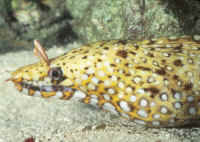
Dragon morays, Echelychore pardalis from Hawaii are striking with white bodies and variegated black, yellow and red markings. Their name derives from the presence of elongate, pointed jaws and long posterior nostril tubes. They command a high price for their beauty and adaptability, and are worth it. Attractive to a lesser degree, but frequently seen in the trade, the Mediterranean Muraena helena reaches the about half the Dragon Moray's length, about two feet.
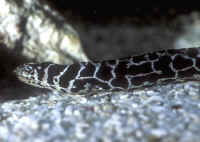
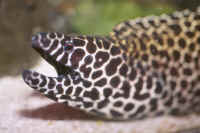
Gymnothorax favagineus (Bloch & Schneider 1801), the Leopard Moray is one of the few members of the genus I can honestly endorse for home use. Most just get too big and mean. It is a handsome brownish black overall with a network of white to yellow reticulations. (Bloch & Schneider 1801), the leopard moray is the only member of the genus I can honestly endorse for home use, the other members getting too big and mean. It is a handsome brownish black overall with a network of white to yellow reticulations. G. permistus is a junior synonym of G. favagineus. Shown: ten inch and three foot individuals in captivity.
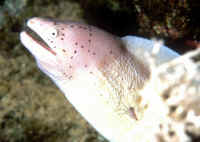
The Gray Moray, Gymnothorax (Siderea) griseus (Lacepede 1803), is a small (three foot max.) compatible species, though expensive; hailing from the Red Sea and west Indian Ocean. Red Sea photo.
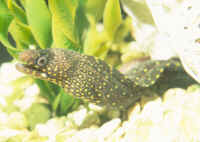
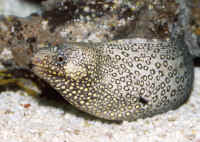
Gymnothorax lentiginosa Jenyns 1842, the Jewel Moray. Eastern Pacific; Mexico's Baja to Peru. To about two feet in length. Another delightfully small member of the genus. Shown: a one foot juvenile and a near maximum size individual in captivity.
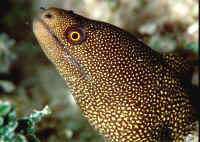
Gymnothorax miliaris Kaup 1856, the Golden Tail Moray. Western Atlantic; Florida to the Antilles. To twenty eight inches in length. One of my favorite aquarium members of the family due to its inherent small size, good looks, and good numbers to be found in the wild. This one off of Bimini.
Species to Generally Avoid:
I know I'm going to get heat for this section as usual. There are folks who have had Moorish idols that thrived on banana chips; still others carrying on clairvoyant relationships with their Ornatissimus butterflies. I've seen this, have mercy! But for most of us mere mortals the following does hold true.
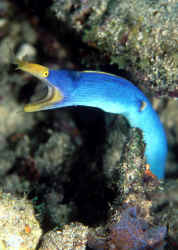
Rhinomuraena species, the Ribbon Moray Eels. Ninety nine percent plus do not live a month in captivity. Most starve, refusing all food. Next most common category of loss is escape through the smallest of top openings, or plumbing. Last is "simple stress".
The written record shows some people's success with netting food and eel together and shaking, training on select live skewered items; but most black to blue to all yellow female ribbon morays perish within a short while. You've been cautioned. Fiji image.
Most Gymnothorax species get too big, are too aggressive and strong for all but the most humungous systems. If you're going to try these, watch your fingers, tankmates and lock (yes, lock!) that cover down. For cooler water species, do invest in and run a chiller. species get too big, are too aggressive and strong for all but the most humungous systems. If you're going to try these, watch your fingers, tankmates and lock (yes, lock!) that cover down. For cooler water species, do invest in and run a chiller.
Often offered to the hobby are the Atlantic green G. funebris, to eight feet! Others include G. javanicus, the Javan or Giant Moray (to ten feet!) and G. flavimarginatus to a mere four feet.
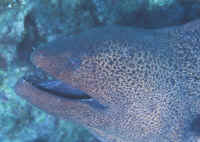
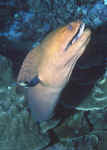
Gymnothorax javanicus (Bleeker 1859), Giant Moray. To ten feet, 3 meters in length. Indo-Pacific; Red Sea, East Africa to Hawai'i. Feeds principally on fishes, secondarily on crustaceans. Largest Moray species according to Fishbase. Shown here in the Red Sea and Fiji.
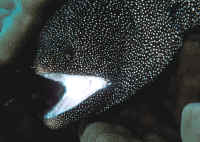
Gymnothorax meleagris (Shaw & Nodder 1795), the White Mouth Moray. Brown to black with numerous white spots. Dark spot around gill opening. Indo-Pacific. Most common Hawaiian puhi/moray. To about forty inches in length. Hawai'i image.
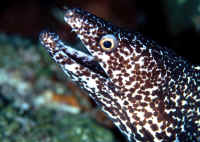
Gymnothorax moringa Cuvier 1829, the Spotted Moray Eel. Tropical eastern and western Atlantic coasts. To four feet in length. Common in the wild. Bahamas pic.
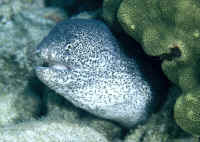
Gymnothorax pictus (Ahl 1789), the Peppered Moray. Indo-Pacific; East Africa to the eastern Pacific, Hawai'i. To five feet in length. This one off Kona.
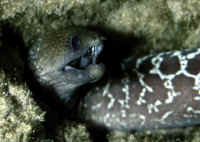
Gymnothorax undulatus (Lacepede 1803), the Undulated Moray. Indo-Pacific; East Africa to the French Polynesia, Hawai'i. To five and a half feet in length. This one in Hawai'i.
Other Morays:
With eleven genera and roughly 165 described species, you can be sure to see an "oddball" Moray eel if you keep your eyes open... Know what you're getting into if you intend to try one of these unknowns... At least look up the species in ICLARM's Fishbase (www.fishbase.com) under the family name, Muraenidae... to gain some insights into how big the species gets, what it eats...
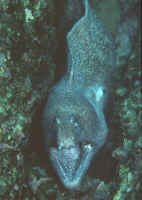
Muraena argus (Steindachner 1870), the White-Spotted Moray. Eastern Pacific; Mexico to Peru. To a meter in length. This one off of Cabo San Lucas, Mexico's Baja tip.
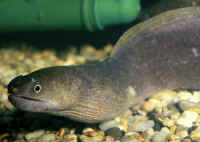
About Freshwater Morays:
There are some species of muraenids that occasionally enter freshwater in tropical and temperate areas. Click on the link above for coverage.
Conclusions:
The favored species mentioned make excellent aquarium specimens, a majority of individuals adapting to aquarium care easily, readily accepting prepared foods, neither launching themselves out of your system, nor sampling their tankmates or your hand when doing routine maintenance. Once acclimated to a tank they prove durable, disease resistant pets.
Other moray species are problematical, growing too large, escaping even the most heavily covered tank. Many starve outright refusing all food, others consider all within their capacious jaws as fair game.
Forewarned is forearmed. The vast majority of muraenids are suitable only for public aquaria or visiting in their domain.
It is my opinion that morays provide predatory pressure in a role similar to several sharks, cleaning up the reefs by eating weakened, damaged prey. They should be there.
Bibliography/Further Reading:
Axelrod, H.R., Burgess, W.E. & R.E. Hunziker III. 1990. Atlas of Aquarium Fishes, Vol. 1 Marine Fish. T.F.H. Publ. Inc., N.J..
Campbell, Douglas C.. 1980. Morays, the Ever Popular Eels. Freshwater and Marine Aquarium. 10/80.
Castro, Alfred D. 2001. A freshwater moray eel? AFM 8/2001.
Chlupaty, P. Undated. The Leopard Moray, an exciting yet beautiful predator. Aquarium Digest Intl. #37.
Esterbauer, Hans. 1994. The Ecology & Behavior of Moray Eels. Tropical Fish Hobbyist. 2/94.
Fenner, Robert. 2000. The Zebra Moray Eel, Gymnomuraena zebra. FAMA 7/00.
Fenner, Robert. 1995. Moray eels of the family Muraenidae. TFH 3/95.
Gonzales, Deane. 1976. Puhi (Eel in Hawaiian). Marine Aquarist. 7(7):76.
Hemdal, Jay. 1986. The Ribbon Eel (Rhinomuraena quaesita). Freshwater and Marine Aquarist. 2/86.
Howe, Jeffrey C. 1997. Original Descriptions (column). Siderea flavocula Bohlke and Randall 1996. FAMA 12/97.
Margaritas, Anargyros. 1988. Sea Serpents in Your Home. Tropical Fish Hobbyist. 11/88.
Michael, Scott W. 1996. Fishes for the marine aquarium, pts. 22, 23; The morays- serpents of the sea. Aquarium Fish Magazine 7,8/96.
Neal, Tom. 1994. Keeping the Ribbon Eel. Tropical Fish Hobbyist. 5/94.
Nelson, Joseph. 1976. Fishes of the World. John Wiley & Sons.